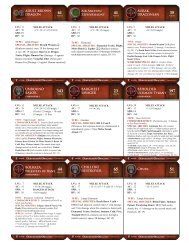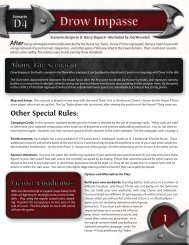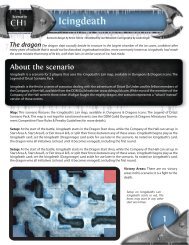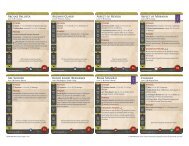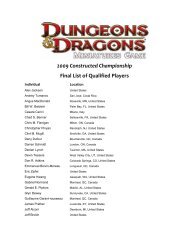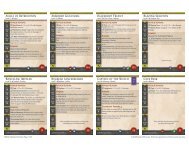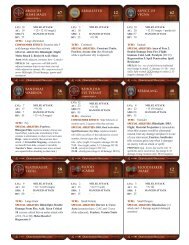Create successful ePaper yourself
Turn your PDF publications into a flip-book with our unique Google optimized e-Paper software.
Cover and Melee Combat<br />
Cover makes it harder to hit an enemy. If an<br />
enemy creature is adjacent to the attacker but<br />
around a corner or end of wall, it has melee<br />
cover and gets a +4 bonus on AC against<br />
that attacker.<br />
Big Creatures: When a creature takes up more<br />
than 1 square, it doesn’t get melee cover if<br />
any of the squares it occupies doesn’t have<br />
melee cover.<br />
Attacks of Opportunity<br />
If an enemy moves out of a square threatened<br />
by a creature, the creature may make a single<br />
immediate melee attack against that enemy.<br />
This is called an attack of opportunity.<br />
One Per Turn: There is no limit to the number<br />
of attacks of opportunity a creature can make<br />
in a round, but it can make only one in a<br />
given creature’s turn.<br />
Timing: A creature makes an attack of<br />
opportunity in response to an enemy’s<br />
movement. The attack takes place when the<br />
enemy is about to leave the threatened square,<br />
but before it actually does. Pause the<br />
movement and make the attack; if the enemy<br />
survives, it continues moving.<br />
Choose Your Attack: If the attacking creature can make multiple melee attacks, choose which<br />
single attack it uses for its attack of opportunity.<br />
Cover in Melee: A creature can’t make an attack of opportunity if the defender has melee<br />
cover against it.<br />
Line of Sight: A creature can’t make an attack of opportunity if it doesn’t have line of sight to<br />
the enemy (see Line of Sight on page 15).<br />
Legal Position: If a creature ends its turn in an illegal position as a consequence of an<br />
enemy’s attack of opportunity (or any other circumstance), move it to its player’s choice of the<br />
nearest legal squares.<br />
CHARGING<br />
A creature might be able to charge the nearest enemy.<br />
To charge, a creature moves at double speed directly toward the nearest enemy within line<br />
of sight and must finish its movement in the nearest space adjacent to that enemy (including<br />
diagonally adjacent). If it has a clear path, nothing slows it down, and it moves at least 2<br />
squares, that creature can make a single melee attack against that enemy with a +2 bonus on its<br />
attack roll.<br />
Nearest Space: The charging creature must move to the nearest space adjacent to the nearest<br />
enemy. If this space is blocked or occupied, the creature can’t charge. If more than one space<br />
counts as the nearest, you can choose any of them to charge to.<br />
13



